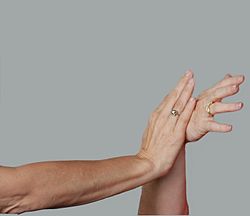Pushing hands




Pushing hands or Tui Shou is a training routine practiced in internal martial arts, especially in Tai Chi Chuan (Taijiquan). It involves two participants who work to improve their martial arts skills, such as balance, timing, and sensitivity to the direction and strength of a partner's intention. This practice is fundamental in Tai Chi and is used as a bridge between solo forms, which are sequences of movements practiced alone, and martial application against an opponent.
Overview[edit]
Pushing hands works on the principle of softness overcoming hardness. Through gentle, cooperative effort, practitioners learn to yield to force and redirect it, rather than opposing it directly. This is in line with the Tai Chi principle of "using the soft to defeat the hard." The practice is not only about physical skills but also about developing a deeper understanding of one's energy (Qi) and how to control and flow with it.
Techniques and Training[edit]
The basic techniques in pushing hands involve single-handed and double-handed drills. These drills are designed to teach the practitioners how to maintain their balance, root, and center while attempting to unbalance their partner. The exercises progress from fixed-step drills, where the feet remain in place, to moving-step drills, which allow movement around the area.
- Single-Handed Pushing Hands: This is usually the first drill learned, focusing on one hand to feel and redirect the partner's force.
- Double-Handed Pushing Hands: This involves both hands and adds complexity, requiring greater coordination and sensitivity.
- Fixed-Step: In these drills, practitioners are not allowed to move their feet, emphasizing upper body skills and root.
- Moving-Step: This allows practitioners to step around, adding mobility and the ability to apply techniques in a more dynamic context.
Competitions[edit]
Pushing hands competitions are held, where the objective is to push the opponent off balance or out of a marked area. These competitions test a practitioner's skill in applying the principles of Tai Chi in a semi-competitive environment. The rules vary, but generally, strikes are not allowed, and the focus is on skillful manipulation of force rather than brute strength.
Benefits[edit]
The benefits of practicing pushing hands extend beyond martial applications. It improves balance, coordination, and body awareness. Practitioners also report improvements in mental and emotional well-being, as the practice encourages mindfulness and a calm, focused state of mind.
Cultural Significance[edit]
Pushing hands is deeply embedded in Chinese martial arts culture and philosophy. It exemplifies the Taoist principles of balance and harmony, teaching practitioners to meet force with softness and to find strength in flexibility.
Ad. Transform your life with W8MD's Budget GLP-1 injections from $75


W8MD offers a medical weight loss program to lose weight in Philadelphia. Our physician-supervised medical weight loss provides:
- Weight loss injections in NYC (generic and brand names):
- Zepbound / Mounjaro, Wegovy / Ozempic, Saxenda
- Most insurances accepted or discounted self-pay rates. We will obtain insurance prior authorizations if needed.
- Generic GLP1 weight loss injections from $75 for the starting dose.
- Also offer prescription weight loss medications including Phentermine, Qsymia, Diethylpropion, Contrave etc.
NYC weight loss doctor appointmentsNYC weight loss doctor appointments
Start your NYC weight loss journey today at our NYC medical weight loss and Philadelphia medical weight loss clinics.
- Call 718-946-5500 to lose weight in NYC or for medical weight loss in Philadelphia 215-676-2334.
- Tags:NYC medical weight loss, Philadelphia lose weight Zepbound NYC, Budget GLP1 weight loss injections, Wegovy Philadelphia, Wegovy NYC, Philadelphia medical weight loss, Brookly weight loss and Wegovy NYC
|
WikiMD's Wellness Encyclopedia |
| Let Food Be Thy Medicine Medicine Thy Food - Hippocrates |
Medical Disclaimer: WikiMD is not a substitute for professional medical advice. The information on WikiMD is provided as an information resource only, may be incorrect, outdated or misleading, and is not to be used or relied on for any diagnostic or treatment purposes. Please consult your health care provider before making any healthcare decisions or for guidance about a specific medical condition. WikiMD expressly disclaims responsibility, and shall have no liability, for any damages, loss, injury, or liability whatsoever suffered as a result of your reliance on the information contained in this site. By visiting this site you agree to the foregoing terms and conditions, which may from time to time be changed or supplemented by WikiMD. If you do not agree to the foregoing terms and conditions, you should not enter or use this site. See full disclaimer.
Credits:Most images are courtesy of Wikimedia commons, and templates, categories Wikipedia, licensed under CC BY SA or similar.
Translate this page: - East Asian
中文,
日本,
한국어,
South Asian
हिन्दी,
தமிழ்,
తెలుగు,
Urdu,
ಕನ್ನಡ,
Southeast Asian
Indonesian,
Vietnamese,
Thai,
မြန်မာဘာသာ,
বাংলা
European
español,
Deutsch,
français,
Greek,
português do Brasil,
polski,
română,
русский,
Nederlands,
norsk,
svenska,
suomi,
Italian
Middle Eastern & African
عربى,
Turkish,
Persian,
Hebrew,
Afrikaans,
isiZulu,
Kiswahili,
Other
Bulgarian,
Hungarian,
Czech,
Swedish,
മലയാളം,
मराठी,
ਪੰਜਾਬੀ,
ગુજરાતી,
Portuguese,
Ukrainian
